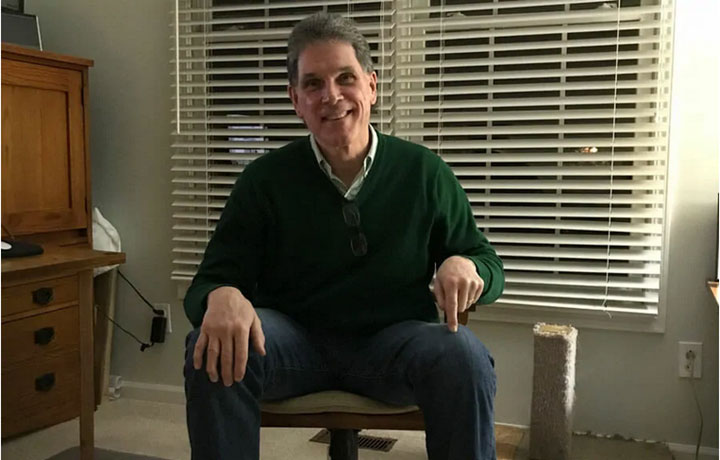“Did you see the video of me biking for the first time in 25 years?” asks Rob McClean enthusiastically. His question comes just a few months after a complicated knee-fusion-disassembly surgery finally allowed him to bend his knee–something he could not do for more than two decades.

After experiencing chronic pain and infection for years, McClean, 61, a power train integration engineer from Detroit, underwent surgery to have his knee fused. While the fusion stopped the pain it also greatly affected his mobility, impacting his quality of life. Twenty-three years later, McClean finally found the solution he had been waiting for.
A long, painful journey
As a younger man McClean would play basketball, run and bike, among other sports. However, when he was in his twenties he ruptured his anterior cruciate ligament (ACL) playing football and ended up in a leg cast for six weeks. A year later his knee was still unstable, requiring yet another leg cast and a knee stabilizing procedure that bought him just a few short years of relief.
“Things seemed to be working well for about four or five years after that,” McClean says, “until my knee began swelling and shedding bone fragments and chips.” He felt like he was stuck in a cycle of chronic pain and infection with no apparent solution in sight. McClean eventually ended up at the Mayo Clinic where a doctor discovered he had an infection in both his femur and tibia. The doctor gave McClean two choices: debridement surgery or knee fusion.
McClean opted for debridement but the surgery was not successful. “I was in extreme pain and my knee was still swelling and needed regular draining,” McClean recalls. His only remaining option was knee fusion surgery where the knee joint is removed and the two ends of the leg bones are fused together, resulting in the inability to bend the leg. “The doctor at the Mayo Clinic gave me sage advice about the bone fusion surgery: ‘Wait as long as possible–and then wait some more,’” McClean explains. A year later he was ready to commit to the procedure. He had had enough of extreme pain.
Despite the loss of mobility and awkwardness of having to drag his leg around after the knee fusion surgery, McClean was finally pain free–and off of pain medication—for the first time in a long time. “The bad part was that now I had to walk with a limp—but I learned to deal with that,” McClean says.
A new hope for mobility
Over time, McClean began thinking about the possibility of a knee fusion reversal. Unfortunately, none of his doctors knew of any surgeon willing or able to perform the operation. He was told the procedure had been tried with poor outcomes and was simply too risky.
Then in July 2017, neighbors introduced McClean to a doctor friend who was familiar with the pioneering work of Henry Finn, M.D., Medical Director of the Chicago Center for Orthopedics at Weiss Memorial Hospital and professor of orthopedic surgery at the University of Chicago. “I was floored when this new acquaintance of ours said, ‘You know, you can get that reversed,’ referring to my fused knee,” says McClean.
By August, McClean had met with Dr. Henry Finn to learn about the radical procedure and to determine if McClean wanted to go through with the risky surgery. With knee fusion disassemble surgery, Dr. Finn cuts through the fused bone and implants a mechanical joint to act as a knee joint would. The hardware extends almost from the hip to the ankle. The surgery is dangerous because the saw must come very close to the major artery and nerves. “I make sure to have a vascular surgeon available during the surgery in case something goes wrong,” explains Dr. Finn.
Dr. Finn remained straightforward with McClean every step of the way, making sure McClean was fully aware of the surgical risks. “Patients must have the proper mental attitude and consider loss of limb an acceptable risk,” stresses Dr. Finn. “Bone fusion surgery causes a major disability that impacts every aspect of your life. How you live, work, travel. If patients are willing to accept the risk, I am willing to perform this surgery so that people can get their lives back,” explains Dr. Finn.
While McClean was not in any pain with the fused left knee he did notice that he was starting to feel pain in his right hip and knee from having to drag around his left leg for so many years. McClean decided that it was worth the risk.
From the beginning McClean appreciated Dr. Finn’s personal touch. “He treated me as a person, not a knee patient. Dr. Finn really wanted to help me function as a whole person again, and I am really grateful for his skills as a surgeon,” McClean says.
The doctor and the device
Dr. Finn has performed more than 60 fusion disassembly surgeries, all with successful outcomes except one. He credits his own Finn Knee® for this success rate. “Conventional prosthetic knee replacements will not work with this procedure. A conventional knee replacement just puts new surfaces on the ends of the bones and still relies on ligaments and normal boney anatomy. The Finn Knee works because it substitutes for all major ligaments and any amount of bone loss,” explains Dr. Finn.
According to Dr. Finn, McClean was an ideal patient for this procedure being 60+ years in age, with his leg muscles and tendons intact, and infection free for more than five years. McClean also had an optimistic outlook and proper mental attitude to handle the outcome.
A bright future
McClean’s final check-up was this past December and Dr. Finn was pleased with his progress. The hardware was adhering to bone and he was happy with McClean’s range of motion. “Every limb has a different story—and different outcome after surgery,” says Dr. Finn. “McClean’s quick recovery can be attributed to his high level of commitment and determination.”
As physical therapy wraps up, McClean cheerfully reports that while he still has a little pain, it does not stop him from bending his knee fully and that he has a lot more energy now that he no longer has to drag his left leg around.
“I’m looking forward to going back to work and to playing golf again with two knees able to bend. I may even try bowling. But the most important thing I am looking forward to is dancing with my wife and our two daughters,” says an emotional husband and father who feels blessed to be whole again.
